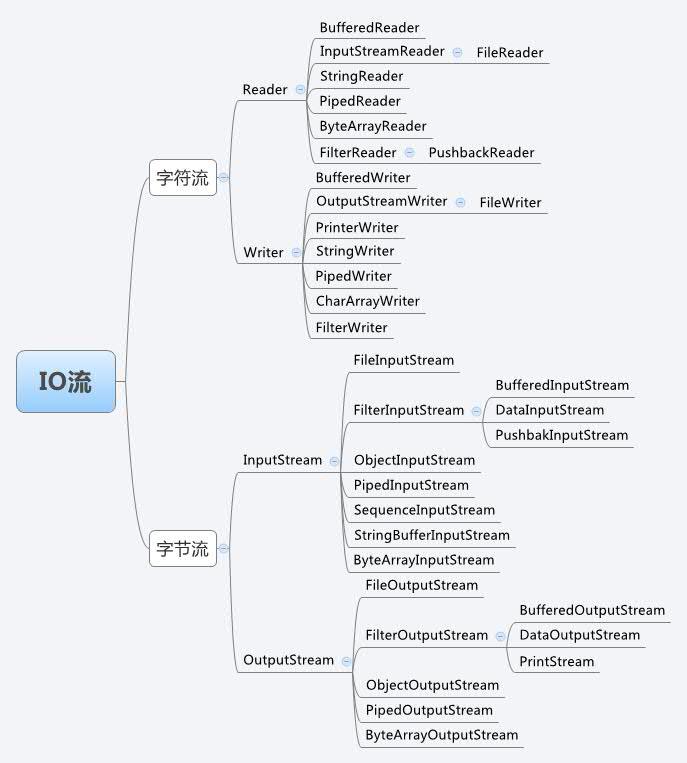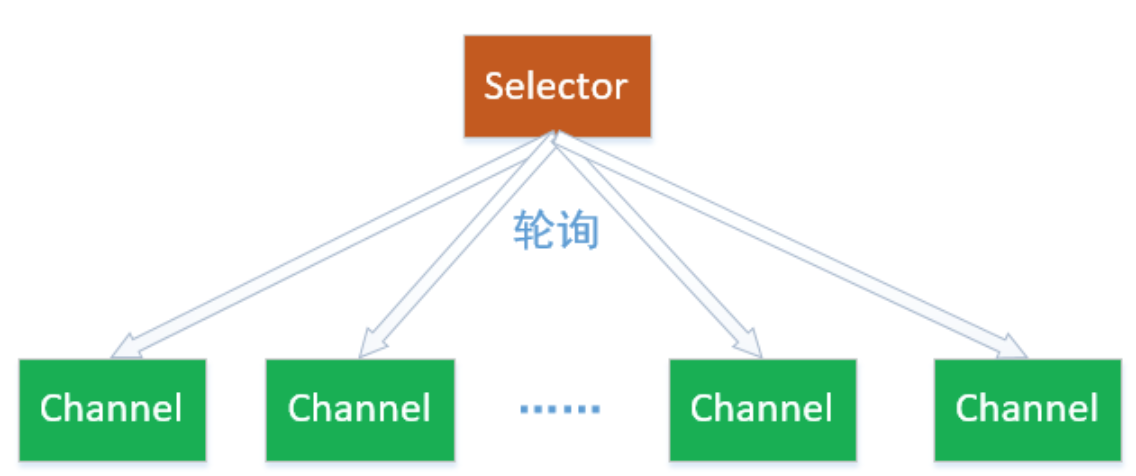JAVA/NIO
IO流
流的概念和作用
流的本质:数据传输,根据数据传输特性将流抽象为各种类,方便更直观的进行数据操作
作用:为数据源和目的地建立一个输送通道
Java IO所采用的模型
Java的IO模型设计非常优秀,它使用Decorator(装饰者)模式,按功能划分Stream,您可以动态装配这些Stream,以便获得您需要的功能。
IO流的分类

按数据流的方向分为 输入流、输出流
按处理数据单位不同分为 字节流、字符流
按功能不同分为 节点流、处理流
Java 的 I/O 操作类在包 java.io 下,大概有将近 80 个类,但是这些类大概可以分成四组
基本的抽象流类型,所有的流都继承自如下四个接口
输入流 输出流
字节流 InputStream outputStream
字符流 Reader Writer
NIO
一种叫非阻塞IO(Non-blocking I/O),另一种也叫新的IO(New I/O),其实是同一个概念。
它是一种同步非阻塞的I/O模型,也是I/O多路复用的基础
IO分阻塞型IO和非阻塞型IO(NIO)
阻塞型IO在读取数据时,如果数据未到达,会一直阻塞到读取到数据为止,所以称为阻塞型IO,在高并发的环境下性能不佳。
NIO不是使用 “流” 来作为数据的传输方式,而是使用通道,通道的数据传输是双向的,且NIO的数据写入和读取都是异步的,不会阻塞线程,所以称为非阻塞型IO,在高并发的环境下性能很好。
NIO主要有三大核心部分:Channel(通道),Buffer(缓冲区), Selector。
Channel
Channel(通道)表示到实体,如硬件设备、文件、网络套接字或可以执行一个或多个不同 I/O 操作(如读取或写入)的程序组件的开放的连接。Channel接口的常用实现类有FileChannel(对应文件IO)、DatagramChannel(对应UDP)、SocketChannel和ServerSocketChannel(对应TCP的客户端和服务器端)。Channel和IO中的Stream(流)是差不多一个等级的。只不过Stream是单向的,譬如:InputStream, OutputStream.而Channel是双向的,既可以用来进行读操作,又可以用来进行写操作。
这些是Java NIO中最重要的通道的实现:
- FileChannel
- DatagramChannel
- SocketChannel
- ServerSocketChannel
FileChannel 从文件中读写数据。
DatagramChannel 能通过UDP读写网络中的数据。
SocketChannel 能通过TCP读写网络中的数据。
ServerSocketChannel可以监听新进来的TCP连接,像Web服务器那样。对每一个新进来的连接都会创建一个SocketChannel。
Selector(选择器)介绍
Selector 一般称 为选择器 ,当然你也可以翻译为 多路复用器 。它是Java NIO核心组件中的一个,用于检查一个或多个NIO Channel(通道)的状态是否处于可读、可写。如此可以实现单线程管理多个channels,也就是可以管理多个网络链接。

使用Selector的好处在于: 使用更少的线程来就可以来处理通道了, 相比使用多个线程,避免了线程上下文切换带来的开销。
Buffer
使用Buffer读写数据一般遵循以下四个步骤:
- 写入数据到Buffer
- 调用
flip()方法 - 从Buffer中读取数据
- 调用
clear()方法或者compact()方法

当向buffer写入数据时,buffer会记录下写了多少数据。一旦要读取数据,需要通过flip()方法将Buffer从写模式切换到读模式。在读模式下,可以读取之前写入到buffer的所有数据。
一旦读完了所有的数据,就需要清空缓冲区,让它可以再次被写入。有两种方式能清空缓冲区:调用clear()或compact()方法。clear()方法会清空整个缓冲区。compact()方法只会清除已经读过的数据。任何未读的数据都被移到缓冲区的起始处,新写入的数据将放到缓冲区未读数据的后面。
服务端代码
package nio;
import java.io.IOException;
import java.net.InetSocketAddress;
import java.nio.ByteBuffer;
import java.nio.channels.ClosedChannelException;
import java.nio.channels.SelectionKey;
import java.nio.channels.Selector;
import java.nio.channels.ServerSocketChannel;
import java.nio.channels.SocketChannel;
import java.util.*;
import java.util.concurrent.ConcurrentHashMap;
public class Server {
private Selector selector;
private ByteBuffer readBuffer = ByteBuffer.allocate(1024);//调整缓存的大小可以看到打印输出的变化
private ByteBuffer sendBuffer = ByteBuffer.allocate(1024);//调整缓存的大小可以看到打印输出的变化
String str;
public void start() throws IOException {
// 打开服务器套接字通道
ServerSocketChannel ssc = ServerSocketChannel.open();
// 服务器配置为非阻塞
ssc.configureBlocking(false);
// 进行服务的绑定
ssc.bind(new InetSocketAddress("localhost", 8001));
// 通过open()方法找到Selector
selector = Selector.open();
// 注册到selector,等待连接
ssc.register(selector, SelectionKey.OP_ACCEPT);
while (!Thread.currentThread().isInterrupted()) {
selector.select();
Set<SelectionKey> keys = selector.selectedKeys();
Iterator<SelectionKey> keyIterator = keys.iterator();
while (keyIterator.hasNext()) {
SelectionKey key = keyIterator.next();
if (!key.isValid()) {
continue;
}
if (key.isAcceptable()) {
accept(key);
} else if (key.isReadable()) {


